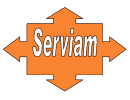


Serviam Implementation Pattern catalogue
The Serviam micro architectural pattern catalogue contains a set of documented best-practices covering the low-lewel design and implementation of Web services.
The best practices are documented using a pattern template, and structured according to pattern types:
- Discovery
- Interface
- Message structure
- Communication
Discovery patterns describe solutions that enable a service consumer to find and connect to services belonging to one or several service providers.
| If You are looking for this |
Find it here |
How to isolate the UDDI code that selects a web service. |
|
How to find services dynamically, e.g. in runtime, and start using them at once without having to modify any code first, and without caring about which platform and programming language the service is implemented with. |
|
Interface pattern describes how to use a service interface to archive a certain goal. Compared to communication patters, interface pattern are focused on describing different types of interfaces rather than the message exchanges between service interfaces.
| If You are looking for this |
Find it here |
How to provide a general and loosely coupled Web Service interface that will not need to be modified in the future when services are being added or updated. |
|
How to aggregate business activities into a business process with a coarse-grained interface while also letting the participating activities exchange data. |
|
How to provide a Web Service interface and reuse business logic that also can be reused from other contexts than web services. |
|
How to create an interface if the WSDL generation tool only can generate classes. |
Message structure patterns are concerned with how the information contents of the messages are structured.
| If You are looking for this |
Find it here |
How to ensure a consistent view of some data while also reducing network traffic. |
|
How to change a non-primitive property for a business object exposed as a web service, considering that SOAP messages are stateless. |
Communication patterns describe solutions focused on sequences of message exchange between services.
| If You are looking for this |
Find it here |
How to let the client execute a long-running Web Service and return quickly without locking the client process. |
|
How to determine when a long-running web service has finished, when you do not want to block the client with a synchronous invocation of the web service. |
|
How to receive notifications from remote long-running web services into your client application when it is not integrated with a web service engine. |
|
How to send web service notifications to clients about generic events that have originated from sources that may not provide web service notification mechanisms themselves. |
|
How to enable easy communication between different architectures as if they were one single component and to do this without forcing the application programmers to first manually create classes, which deal with the low-level and protocol-specific programming. |
| Extra material! |
|
|
Externa länkar: |
| www.ssek.org |
| www.vinnova.se |
| Huvudsponsor: |
| kontakt: Peter Söderström (IT Plan) | Martin Henkel (Stockholms Universitet) | Web utvecklad av: Milena Haykowska (Stockholms Universitet) |